How Your Mind Takes Decisions For You

An individual has been described by a neighbour as follows: “Steve is very shy and withdrawn, invariably helpful but with little interest in people or in the world of reality. A meek & tidy soul, he has a need for order and structure, and a passion for detail.” Is Steve more likely to be a librarian or a farmer?
Probably your first thought was Librarian. Indeed - Steve’s description matches the stereotype of Librarian very well. But did you take into account the number of farmers versus the number of librarians? And the impact of these population sizes on the chances of Steve being a Librarian? A large farmer population will significantly raise his chances to be one himself - despite his meek & tidy soul.
This is just one of the many examples in Daniel Kahneman’s book “Thinking, Fast & Slow”, that illustrates the way our mind works. He (Nobel Prize Winner 2002) models our mind with two systems, driving the way we think. System 1 is fast, intuitive and emotional. System 2 is slower, more deliberative, and more logical. The interaction between the two leads to a very sofisticated decision taking machine, but also introduces faults & biases that heavily impact our judgements and decisions.
Conclusion of my reading?
- Step 1: Build awareness of the decision faults & biases.
- Step 2: For important decisions, take the time to have your System 2 have its deliberations
- Step 3: Underpin your decision taking proces by facts & figures
